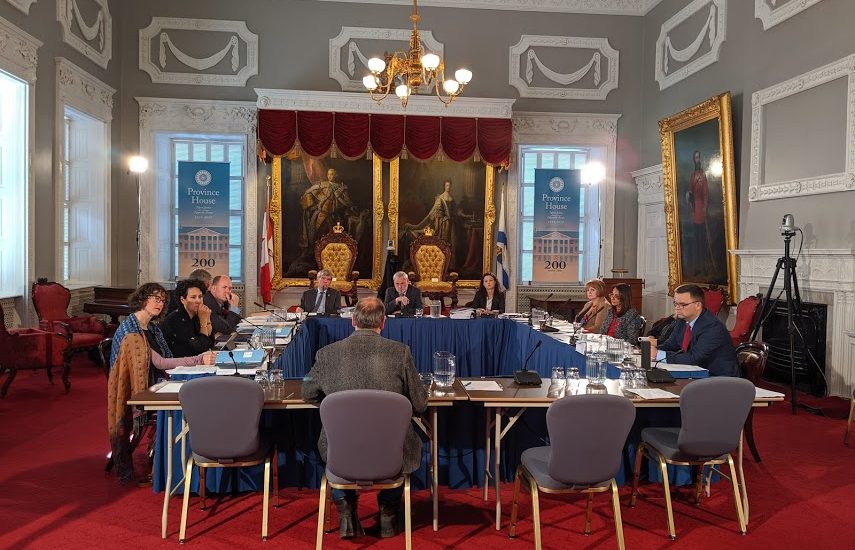Christine Saulnier comments on the proposed Bill 213, the Sustainable Development Goals Act, at Law Amendments this morning, making some great points about its urgency and the importance of climate justice in all of this. Christine is the director of the Nova Scotia chapter of the Canadian Centre for Policy Alternatives.
“A climate justice approach goes further to ensure that the underlying social and economic inequities are addressed—without such an explicit focus this transition risks making these inequities worse,” she says.

I am here today because we owe it to our youth to ensure that they have a future. I joined the youth this past Friday as they held a silent protest for bold ambitious action to address the climate crisis. Still fresh in our minds should be the September protest that was the largest in our history. As government, you owe it to them to do everything in your power to take such bold, ambitious action. Unfortunately, what has been tabled does not go far enough.
FIRST, with regards to emissions targets (7.c): The new provincial target of 11.2 million tonnes of provincial GHG emissions (53% below 2005 levels) by 2030 needs to go further (7 c). The target must be no more than 9.8 Million tonnes or 58% below 2005 levels by 2030. As a signatory to the 2030 declaration and a member of that network, this is equivalent to our call for legislated GHG reduction target of 50% below 1990 levels by the year 2030. This target represents the minimum emission reductions required by Canadian jurisdictions in order to do our fair share of keeping global temperature rise to below 1.5°C. The government has missed opportunities to reduce emissions more quickly with for example, the weak cap-and-trade system—which by its own accounting will only reduce emissions by a total of 0.65 Mt by 2022—or roughly 0.16 Mt per year. A stronger carbon pricing system could have done more.
Despite what we hear, Nova Scotia needs to do more because:
- While NS’s Greenhouse gas emissions per capita (tonnes CO2e per person) is below the national average, Canada has one of the highest emissions per capita in the world.
- Nova Scotia is above the national average when it comes to Greenhouse gas emissions intensity (Mt CO2e per $1 million GDP).
Carbon-pricing is only one mechanism to reduce emissions and it is one that has, unfortunately, side-tracked discussion on why we need to focus not only on reducing demand for fossil fuels but restricting the supply—that means a plan to phase-out fossil fuel production whether used domestically or exported.
SECOND: I am pleased to see that this legislation in section 4 lays out the principles of sustainability and recognizes that there is a climate emergency. I note the terms circular economy and inclusive economy. I caution that this too does not go far enough. The term justice appears nowhere—and to do this right we need a justice-based transition.
There is a recognition that this is not a one dept initiative, but an approach that is cross governmental—one that uses a sustainability lens for all government decisions as it says in section 11, but, merely including it in a Department’s mandate is a very weak accountability mechanism. How will it be reported—this must be public and not just to the Minister responsible. Through what cross governmental mechanism will this actually have an impact and be measured? Will the 2020 provincial budget use this lens?
What is required to address the climate crisis is a fundamental reframing of what we measure and how, and who is involved.
My organization, the CCPA, has demonstrated how to uses this lens for government budgets; our alternative budgets use the lens of social and economic justice, as well as environmental sustainability—early this year we wrote the framework for a Nova Scotia Green New Deal.
If we (AND we must) prioritize climate justice then for example there would be goals and targets that explicitly states that while we move towards sustainable consumption and production, we seek to end poverty and improve well-being by ensuring better health and housing, and seeking to reduce inequality.
We must prioritize a just transition and ensure there are supports for workers in terms of income support and skills retraining as well as infrastructure investments in affected communities as they undergo the transition to a cleaner economy. There are lots of lessons from Cape Breton on this front.
A climate justice approach goes further to ensure that the underlying social and economic inequities are addressed—without such an explicit focus this transition risks making these inequities worse. Let’s instead take the opportunity to ensure that all those who face costs and risks from the climate crisis and the policies to address it, actually share in the benefits of transition.
THIRD: The Act also establishes a Sustainable Communities Challenge Fund (9.1)—this too I commend with a caveat that there needs to be support directed to those communities who have been disproportionately impacted by the effects of the climate crisis to decrease the barriers they have to participating—ensuring indigenous lead initiatives, African NS lead initiatives—recognizing the affect environmental racism has had, and high poverty rates etc.
FOURTH: I do want to commend the government for requiring public consultation (14, 1.). These consultations must be meaningful and participatory, and not just flipchart, sticky note one-off community meetings where the same people attend, and the same interests dominate.
- Indigenous people and reconciliation must centre in the development of your climate action plans, and requires going far beyond consultation to respecting indigenous rights, treaties and leadership.
- Our youth deserve a say that accommodates them and goes to them and their spaces.
- As with the Fund, there needs to be support directed to those communities who have been disproportionately impacted by the effects of the climate crisis to decrease the barriers they have to participating.
My FIFTH and last point I would like to make is around governance and accountability. There is a lot of cynicism out there about governments not keeping their promises. Much of it is well-founded in evidence. Unfortunately, our electoral system makes it seem as if a government has the support of all the people when in reality it can have far less than even half the voters supporting it and still have all the power to make decisions unilaterally. I do not expect you to prioritize electoral reform, though I would recommend it. I do recommend that you consider placing more of the stipulations that are to be in regulations into this legislation to ensure at least all elected representatives of the people have a say. Section 14.2 that states all the areas for which regulations may be made is very broad and should not just be put into regulations, but enumerated here.
My substantive recommendation, is that instead of section 3 that states that The Minister is responsible for the general supervision and management of this Act and the regulations, there be a provision to set up an independent climate accountability body that does the audits and reports on targets and timelines. It would be arms-length from government, and report directly to the entire legislative assembly.
Strengthening governance and accountability requires the public to have more open access to information and decision-making processes.
The root causes of the climate crisis are those that are also undermining our democracy. The government should take this an opportunity to strengthen our democracy while taking bold and ambitious science-based action to address the climate crisis.
See also: Keep on marching on: Nova Scotia’s new climate change legislation is seriously flawed
With a special thanks to our generous donors who make publication of the Nova Scotia Advocate possible.
Subscribe to the Nova Scotia Advocate weekly digest and never miss an article again. It’s free!



